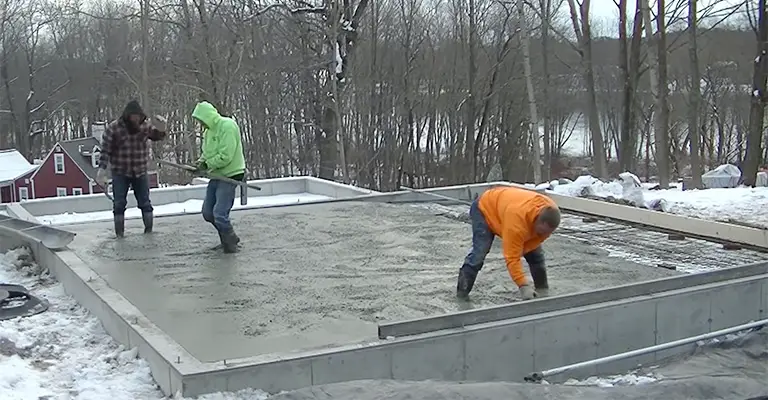Picture yourself on a warm summer’s day, the sun gently casting its golden glow as you step out onto your own outdoor haven. Your patio, a canvas of comfort and style, beckons you to unwind, entertain, and make cherished memories.
As you plan every detail, from the layout to the landscaping, there’s one foundational aspect that often goes overlooked yet holds the key to a patio’s durability and functionality: the thickness of the concrete beneath your feet.
The concrete thickness for a patio depends on various factors, including the intended use of the patio, the local climate, and the soil conditions.
The Ideal Concrete Slab Thickness For Patio
Your concrete slab thickness is determined by the weight you anticipate your patio will have to withstand and how many square feet you intend your patio to be. Most local concrete patio professionals suggest a thickness of 4 inches.
This also complies with most building codes. Many contractors will automatically assume a concrete slab thickness of 4 inches, which is standard.
Some contractors might ask for specific details about patio use and advise accordingly. However, this is often the exception to the rule, so it’s best to foresee your patio use before installing it.
Building codes across the country usually require a thickness of 3.5 inches and compressive strength of 3,000 PSI. However, many things determine whether a concrete patio should be thicker or incorporate rebar/reinforcement mesh.
Concrete Slab Thickness Guide for Robust and Durable Patios
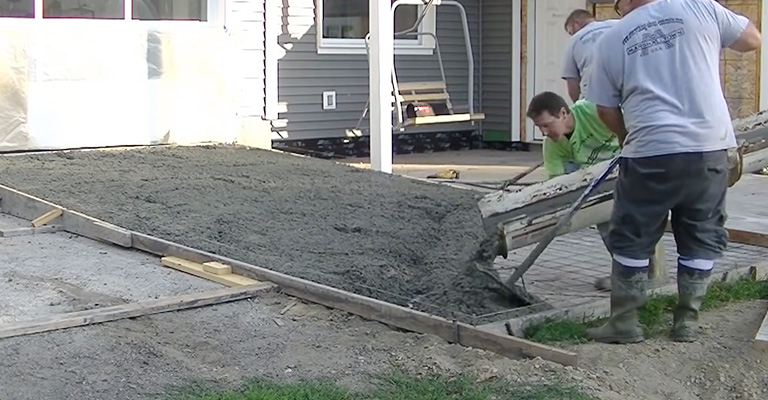
A patio’s best feature is that it has next to zero maintenance. Though you do need to put in a few fine touches here and there, you don’t have to do much to keep up the appearance of your outdoor escapade.
This Varies From One Type To The Next
Three of the most commonly chosen patio types include the paver, stone and concrete slab patio. Among the three, the easiest to sustain are those made out of concrete.
While they come in many forms, the concrete slab is the best option to go for when you are looking for a flat, smooth and stable patio that gives you thermal heating and the best flooring to work with.
Being the best option naturally has its drawbacks. While it may seem quite simple, constructing a Concrete Slab for your patio can be complicated.
I won’t even begin to describe the concrete composition, the placement, and the measurements to erect the slab.
The proper timing and installation of the concrete slab are also crucial to ensuring the stability of your patio flooring. Therefore, let’s get into every detail before we get started.
All You Need To Know
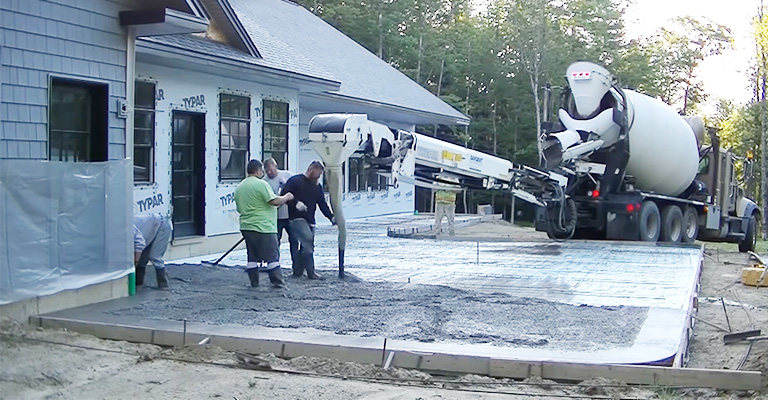
Besides being the strongest, most dependable way to construct a patio, concrete slabs also require very precise measurements and content ratios.
Although from the top, it might look like cement poured on topsoil, underneath, it is an entirely different story.
You may feel tempted to put a concrete slab on top of a shallow pit, but this is not a wise way to approach your patio.
The foundation cannot be guaranteed to be stable if it is only built on the soil. Even perfectly measured slabs can crack under pressure due to gaps in the ground, protruding rocks, or simply weak topsoil.
This is particularly true with patios that are located in extremely hot or cold weather. Concrete slabs can be repaired, but unlike pavers and bricks that can be replaced immediately, a cracked concrete slab cannot be patched up easily.
In order to fill in a crack, you can use cement, but when things get out of hand, such as weeds pushing themselves through the crack or the lines extending further down, you’ll have to replace the whole slab.
However, you should ensure your numbers are correct before digging around your backyard.
Back To The Basics
An excellent building always starts with a solid foundation. You should also build a concrete patio.
You can’t predict how soil will shift over time, but creating a cushion for your concrete slab will help lessen any adverse effects.
Working with a gravel base is the most common and practical way to support your project. Although you might be tempted to pour everything over the concrete slab, it determines the thickness.
For the slab and gravel duo, you can use a 1:1 ratio. Alternatively, you can consult a concrete slab calculator or professional.
However, sticking to 4-6 inches of gravel for your foundation is best. To work your way through an 8-inch pit, if you work with a minimum of 4 inches, you will need to dig a minimum of 4 inches.
Ensuring Patio Durability: The Importance of Concrete Slab Thickness
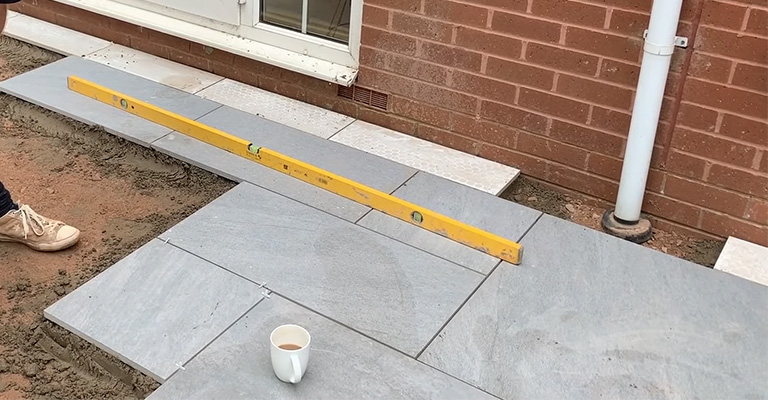
Do you now have the freedom to mess around with your slab? With the wrong materials and incorrect measurements, a house will crumble and fall apart despite a great foundation.
Using this logic, your patio will suffer if you follow the lead of those who ignore details in rushing to build their dream patio.
How Much Weight Can a 4-Inch Concrete Slab Hold?
Considering the weight the concrete slab needs to hold, spread out over its surface, this question is a little more challenging.
Moreover, you should consider the concrete slab’s resistance to cracking and breaking. To measure the concrete’s tensile strength and compressive strength, you have to measure them separately.
A concrete’s compressive strength is measured in PSI – pounds per square inch. It is common to see concrete with PSI ratings of 3,000 and 4,000. Concrete cylinders are tested under a pneumatic press using a 4-inch thick concrete cylinder.
Thus, “4,000 PSI” refers to a 4-inch concrete slab with a standard thickness of 4 inches. A 3-inch slab has a slightly lower compressive strength than a 5-inch slab, so it will be stronger in the long run.
There is no easy way to measure tensile strength. It refers to the ability of a slab to resist cracking or fracturing under uneven pressure.
In the case of a pencil that breaks, its tensile strength is relatively low, so it snaps. The tensile strength of a lengthy section of a non-reinforced concrete slab is also weak.
The weight of a few hundred pounds, although far below its compressive strength, can crack and crumble a concrete slab of too long length.
There is a possibility that concrete could even collapse under its weight without stable ground beneath it. This is why rebar and reinforcement mesh are extensively used to make patios much stronger.
Tips to Ensure the Right Concrete Slab for Your Needs
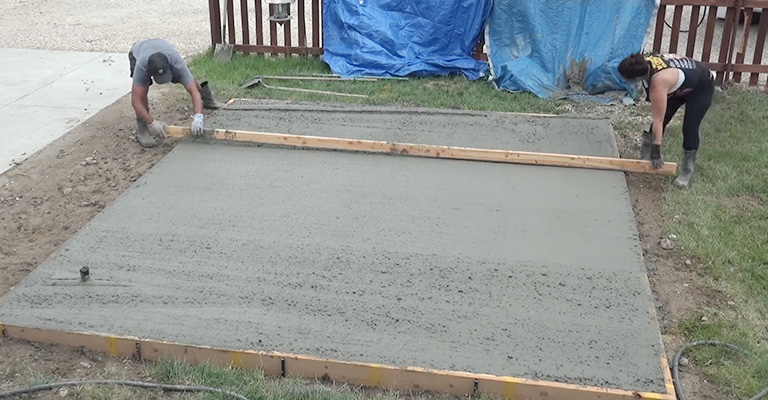
You should be aware of a few general guidelines to ensure the right concrete patio thickness and ensure the slab is appropriate for your home and your patio.
Right Patio Base
Approximately 3 inches of gravel, sand, and fine rocks, layered over a 3/4-inch rock layer that drains well, provide a good base for concrete.
You must prepare the area before pouring concrete over grass to avoid cracks and crevices in the concrete. Preventing shifting and cracks requires a stable base.
In general, there is no need to install a vapour barrier beneath a concrete patio that is on the outside. The use of pours in basements or other indoor areas does, however, require them.
Rebar
You should use rebar or welded wire reinforcement (WWR) when building a 4-inch concrete slab to protect it from cracking and shattering. In addition to being readily available in sheets, WWR is also easy to use since it can be cut to size and expanded.
Do You Need Rebar for a 4-Inch Slab?
In the case of a slab poured on grade in the 4-inch depth, rebar is not required. No reinforcing bars are necessary because the slab will sit on top of the ground, not suspended as part of a structure.
It may be necessary to use rebar in more heavy-duty situations when concrete is suspended in the air, ground support is compromised, or heavy objects are being supported by the structure.
Final Words
If you decide on concrete patio ideas for small yards, there are many details that have to be carefully considered. Otherwise, you will have a patio that won’t last even a month before you have to start working on repairs.
Make sure your concrete slab is no thicker than six (6) inches. If you wish to work with any lesser numbers, it would be best to work them out since one slab can only be installed at a time.
You need to know a few things before you put new concrete over old concrete. Putting one slab on top of another is not only bad but putting two concrete slabs on your patio is also bound to fail.
As an example, if two different concrete slabs were meshing together, the shift in topsoil could cause both to rub off each other. Consequently, your concrete slabs could crack prematurely.

